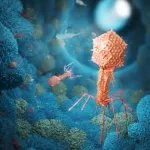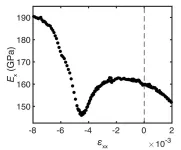(Press-News.org) U.S. government reached a settlement with thousands of families separated under the zero-tolerance policy
Experts highlight ‘mountain of a challenge’ that U.S. Family Reunification Task Force has had in accounting for separations
Task force reuniting families is working within a limited scope of separated families
‘If using DNA data to reunite families could help even one child, it’s worth giving it a shot,’ says researcher
CHICAGO --- Five years since the retraction of the Trump-era zero-tolerance policy on illegal border crossings, which resulted in the separation of more than 5,000 children from their families at the U.S.-Mexico border between 2017 and 2021, a task force is still attempting to reunify and account for separated families.
According to advocates of the Biden administration’s Family Reunification Task Force, the group’s scope isn’t large enough to capture all separated families. Additional complications have arisen because of inconsistencies in data used to track families down, resulting in separated families falling through the cracks.
Genetic justice experts at Northwestern University and the Ann & Robert H. Lurie Children’s Hospital of Chicago have combed through the task force’s semi-monthly public reports to highlight four key findings they hope will raise awareness in addressing the needs of all families separated by U.S. government policies.
Observations include varying definitions of “reunification” throughout different reports; inadequate reporting systems to track separations still ongoing in the U.S.; importance of addressing trauma after families are reunified; and the omission of reporting separations outside the child-parent category. (More detailed information below.)
“Our goal is not to undermine the careful and intentional work of the task force but to highlight the mountain of a challenge they have in accounting for these separations,” said senior author Sara Huston, research assistant professor of pediatrics at Northwestern University Feinberg School of Medicine. “We want to highlight how the numbers the task force reports have importance to the general public. The lack of coverage of what happened to these families is misleading. While the task force is doing the important work, they’re not tasked with covering the full effect of the separations.”
The research team’s commentary was published today (Oct. 26) in the journal Family and Community Health.
Leveraging DNA to reunite families
As of September 2023, approximately 1,000 children were still separated from their families. The task force has not found contact information for 81 of those children’s parents (down from 545 children in 2020). Huston and Diana Madden, the study’s lead and corresponding author, say those are the children who could potentially benefit from a DNA-based database approach, but advocates have been hesitant to use biometrics to reunify families.
“Every child counts,” Huston said. “If using DNA data to reunite these families could help even one child, it’s worth giving it a shot.”
Task force covers a narrow scope
The task force’s mandate covers a limited scope of children, primarily those who were part of the
2018 Ms. L v. ICE lawsuit filed by the American Civil Liberties Union. The commentary authors said the task force reports do not address whether over 1,000 children excluded from the Ms. L class were ultimately deemed eligible for task force support.
“Five years since the separations, the task force is still working hard to rectify the separations that fall within their narrow scope,” said Madden, a research coordinator at Lurie Children’s. “In the meantime, separations have continued to happen and might happen again if our administration shifts. How can we stand on the precipice of more separations happening when we still don’t have solid systems to track when they do happen or how to reunify families?”
With the Oct. 16 release of the proposed settlement negotiation, there are provisions to track future family separations, the authors said.
The commentary is titled, “Accounting for migrant family separations: When numerical chaos exacerbates health inequity.” More details on each observation:
Publicly reported numbers of separated children are challenging to interpret. As of August 2023, the task force has publicly released 14 progress reports. The researchers point out fluctuating definitions for how the term “reunified” is used across the reports. For instance, in some reports, children were “reunified” either in the U.S. or in their own home countries, whereas other reports described them as being “reunified” only in the U.S.
The scope of reunification efforts does not include all families separated by the government at U.S. borders. Those eligible for reunification support include only children who were under 18 when separated from parents or legal guardians at the U.S.-Mexico border between Jan. 20, 2017, and Jan. 20, 2021. The focus on the U.S.-Mexico border likely excludes separations at other border entry points during the time frame of the zero-tolerance policy; the authors are aware of at least one separation at an internal international airport in 2019. Some separations involved U.S. citizens.
The definition of the term “family” excludes non-parental relationships, doesn’t account for varied family structures, leading to an undercount in numbers of true separations. “We don’t know how many families there are that may be genetic aunts or uncles or a sibling over 18 traveling with a sibling under 18,” Madden said. “What happened to those types of pairs? What happens when two children are siblings?”
The total number of reunifications alone cannot account for the breadth and harms of separations. “Reunification is a process, not a conclusion,” Madden said. “These families that do get reunified have not necessarily received any privileges as a resident in the U.S. The privileges and support families do receive will expire, and reparations are absent. Reunification is a goal but not the end point for the trauma that happened to these families.” END
Bacteriophages, also called phages, are viruses that infect and kill bacteria, their natural hosts. But from a macromolecular viewpoint, phages can be viewed as nutritionally enriched packets of nucleotides wrapped in an amino acid shell. A study published October 26th in the open access journal PLOS Biology by Jeremy J. Barr at Monash University, Victoria, Australia, and colleagues suggests that mammalian cells internalize phages as a resource to promote cellular growth and survival.
Phage interactions with bacteria are well known, and interactions between bacteria and their mammalian host can lead ...
New research from the University of Birmingham shows that the electronic structure of metals can strongly affect their mechanical properties.
The research, published today (26th October) in the journal Science, demonstrates experimentally, for the first time, that the electronic and mechanical properties of a metal are connected. It was previously understood theoretically that there would be a connection, but it was thought that it would be too small to detect in an experiment.
Dr Clifford Hicks, Reader in Condensed Matter Physics, who worked on the study said: “Mechanical properties are typically described ...
Semiconductors—most notably, silicon—underpin the computers, cellphones, and other electronic devices that power our daily lives, including the device on which you are reading this article. As ubiquitous as semiconductors have become, they come with limitations. The atomic structure of any material vibrates, which creates quantum particles called phonons. Phonons in turn cause the particles—either electrons or electron-hole pairs called excitons—that carry energy and information around electronic devices to scatter in a matter of nanometers and femtoseconds. This means that energy is lost in the form of heat, and that information transfer has ...
To date, research has suggested that only humans and some species of toothed whales live many years of active life after the loss of reproductive ability. But now, a new study shows female chimpanzees in Uganda show signs of menopause – surviving long past the end of their ability to reproduce. Signs of menopause in wild chimpanzees may provide insights into the evolution of this rare trait in humans. The vast majority of mammals stay fertile until the very ends of their lives, with humans and several species of toothed whales as the outliers; they experience menopause. In humans, menopause ...
For the first time in human history, say Daniel Gervais and John Nay in a Policy Forum, nonhuman entities that are not directed by humans – such as artificial intelligence (AI)-operated corporations – should enter the legal system as a new “species” of legal subject. AI has evolved to the point where it could function as a legal subject with rights and obligations, say the authors. As such, before the issue becomes too complex and difficult to disentangle, “interspecific” legal frameworks need to be developed by which AI can be treated as legal subjects, they write. Until now, the legal system has been univocal ...
While small, the hypothalamus – a complex structure located deep in the brain – plays a gargantuan role in coordinating the wide array of neuronal signals that are responsible for keeping the body in a stable state. In a Special Issue of Science, authors across four Reviews unpack this key brain region’s impact on physiological and behavioral homeostasis.
The hypothalamus consists of a complex collection of neural circuits. These circuits receive, process, and integrate sensory inputs to drive coordinated communication via a range of behavioral, ...
In a Perspective, Stephen Tang and Samuel Sternberg discuss retroelement-based gene editing as a safer alternative to CRISPR-Cas approaches. Precision genome editing technologies have transformed modern biology. Capabilities for programable DNA targeting have improved rapidly, largely due to the development of bacterial RNA-guided CRISPR-Cas systems, which allow precise cleavage of target DNA sequences. However, CRISPR-Cas9 systems generate a DNA double strand break (DSB), which activates cellular DNA repair pathways that can lead to unwanted and complex byproducts, ...
Key takeaways
Female chimpanzees in Uganda’s Ngogo community experienced a menopausal transition similar to women.
Fertility among chimpanzees studied declined after age 30, and no births were observed after age 50.
The data can help researchers better understand why menopause and post-fertile survival occur in nature and how it evolved in the human species.
A team of researchers studying the Ngogo community of wild chimpanzees in western Uganda’s Kibale National Park for two decades has published a report in Science showing that females in this population can ...
The hardness of materials is determined by the strength of the chemical bonds that are formed between the electrons of the neighbouring atoms. For example, the bonds in diamond are very strong, so it is one of the hardest materials known. The bonding is rooted in the laws of quantum mechanics, and the complex compounds that are of most interest in forefront research today are known as ‘quantum materials.’ In many quantum materials, layers of strongly bonded atoms separate layers in ...
Extreme conditions prevail in the Würzburg laboratory of experimental physicists Professor Matthias Bode and Dr. Artem Odobesko. Affiliated with the Cluster of Excellence ct.qmat, a collaboration between JMU Würzburg and TU Dresden, these visionaries are setting new milestones in quantum research. Their latest endeavor is unveiling the spinaron effect. They strategically placed individual cobalt atoms onto a copper surface, brought the temperature down to 1.4 Kelvin (–271.75° Celsius), and then subjected them to a powerful external magnetic field. “The magnet we use costs half a million euros. It’s not something that’s widely available,” explains ...



